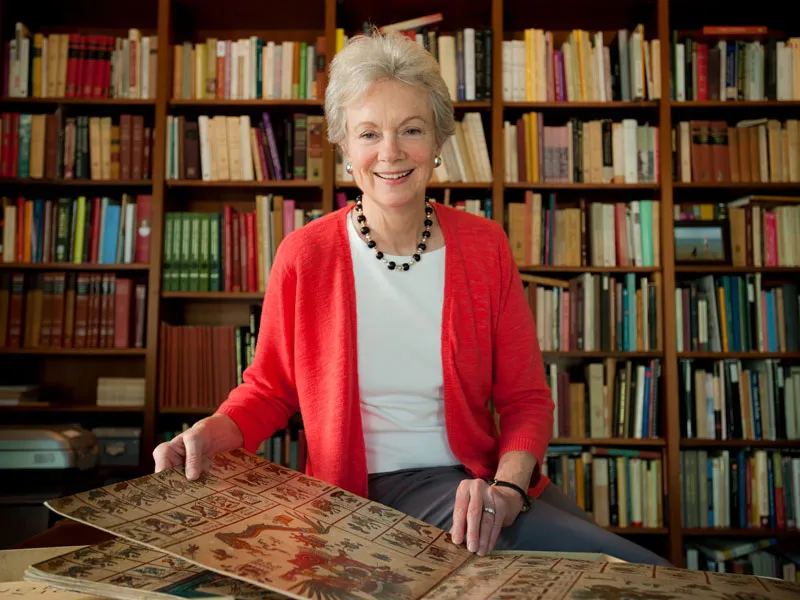
Education
Biography
Elizabeth Boone (Ph.D., University of Texas at Austin, 1977) is a specialist in the Precolumbian and early colonial art of Latin America, with an emphasis on Mexico. Formerly Director of Pre-Columbian Studies at Dumbarton Oaks (1980-95), she has taught art history at Tulane since 1995. In 2006-8 she was the Andrew W. Mellon Professor at the Center for Advanced Study in the Visual Arts at the National Gallery of Art. She is a Fellow of the American Academy of Arts and Sciences and a Corresponding Member of the Academia Mexicana de la Historia. She has been awarded Mexico’s Order of the Aztec Eagle (1990), the College Art Association’s Distinguished Scholar for 2019, and a Lifetime Achievement Award from the American Society for Ethnohistory (2019). She received the Research Hall of Fame Award from Tulane University in 2021. Her research interests range from the history of collecting to systems of writing and notation; they are grounded geographically in Aztec Mexico but extend temporally for at least a century after the Spanish invasion.
Her latest monograph book, Descendants of Mexican Pictography: The Cultural Encyclopedias of Sixteenth-Century Mexico (University of Texas Press, 2021), is the first synthetic analysis of the pictorial encyclopedias of Aztec culture created in the decades of the Spanish conquest, which shows how indigenous pictography adapted under the influence of European script and image-making, and why it retained its agency as a container of truth.
Descendants builds on her previous studies of the painted manuscript tradition of Aztec Mexico. These include Stories in Red and Black: Pictorial Histories of the Aztecs and Mixtecs (University of Texas Press, 2000; Spanish translation, Fondo de Cultura Económica, 2010), which won the Arvey Prize of the Association for Latin American Art, and Cycles of Time and Meaning in the Mexican Books of Fate (University of Texas Press, 2007), which focuses on the figural vocabulary and graphic structure of the divinatory manuscripts. Painted Words: Nahua Catholicism, Politics, and Memory in the Atzaqualco Pictorial Catechism, written with Louise Burkhart and Davíd Tavárez (Dumbarton Oaks, 2017), deciphers a pictographic catechism from colonial Mexico as a particularly indigenous expression of devotional knowledge. A volume of papers edited with Gary Urton, Their Way of Writing: Scripts, Signs, and Pictographies in Pre-Columbian America (Dumbarton Oaks and Harvard Press, 2011), broadly considers Amerindian systems of writing.
Her overriding interest is in the way knowledge is recorded graphically: how, for example, stories about the past can be told pictorially, how religious and mantic concepts can be expressed solely through images, and how images retained their documentary authority after the Spanish conquest. She is interested also in understanding the circumstances in which visual thinking and pictorial expression prove to be more effective than logo-syllabic scripts.
Other recent contributions
"This New World Now Revealed: Hernán Cortés and the Presentation of Mexico to Europe," Word & Image 27, I (2011): 31-46. https://www.tandfonline.com/doi/abs/10.1080/02666281003771190
“The Petroglyphic Prayers on the Sun Stone of Motecuhzoma Ilhuicamina,” Ancient Mesoamerica 24, 2:225-241 (issue dated 2013, issued 2014) https://www.cambridge.org/core/journals/ancient-mesoamerica/article/petroglyphic-prayers-on-the-sun-stone-of-motecuhzoma-ilhuicamina/59766434F6DDE95F7573A879AA819344
“The Painted Histories of Mexico and the Lienzo of Tlapiltepec,” in The Lienzo of Tlapiltepec: A Painted History from the Northern Mixteca, edited by Arni Brownstone, pp. ix-xvii. Royal Ontario Museum and University of Oklahoma Press, 2015.
“Pictorial Talking: The Figural Rendering of Speech Acts and Texts in Aztec Mexico,” in Sign and Design: Script as Image in a Cross-Cultural Perspective (300-1600 CE), edited by Brigitte Miriam Bedos-Rezak and Jeffrey F. Hamburger, pp. 31-50. Dumbarton Oaks, Washington, D.C., 2016.
“Discurso en imagines: la producción Azteca de textos cristianos,” Del saber ha hecho su razón de ser: Homenaje a Alfredo López Austin, edited by Eduardo Matos Moctezuma and Ángela Ochoa, vol. 2, pp. 27-43. Mexico, 2017
“Seeking Indianness: Christoph Weiditz, the Aztecs, and Feathered Amerindians,” Colonial Latin American Review 26, 1:39-61, issue edited by Marcy Norton and Ralph Bauer, 2017. https://www.tandfonline.com/doi/abs/10.1080/10609164.2017.1287323
“The Pictorial History of Coixtlahuaca’s Lienzo Seler II.” In On the Mount of Intertwined Serpents: The Pictorial History of Power, Rule, and Land on Lienzo Seler II, edited by Viola Kónig, pp. 37-44. Berlin: Ethnologisches Museum, Staatliche Museen zu Berlin, 2017
“Who They Are and What they Wore: Aztec Costumes for European Eyes,” Res: Anthropology and Aesthetics 67/68 (2016/2017):316-334. Chicago: University of Chicago Press, 2017.
“Fashioning Conceptual Categories in the Florentine Codex: Old World and Indigenous Foundations for the Rulers and the Gods.” In The Florentine Codex: An Encyclopedia of the Nahua World in Sixteenth Century Mexico, edited by Jeanette Peterson and Kevin Terraciano, pp. 95-109. Austin: University of Texas Press, 2019.
Recently supervised Ph.D. theses 2015-2021
Emily Floyd, joint Art History and Latin American Studies program, Tulane, Ph.D. 2018, “Matrices of Devotion: Lima’s Seventeenth- and Eighteenth-Century Devotional Prints and Local Religion in the Viceroyalty of Peru”
Jennifer Saracino, joint Art History and Latin American Studies program, Tulane, Ph.D. 2018, “Shifting Landscape: Depictions of Cultural Disruption and Continuity in the Mapa Uppsala of Mexico-Tenochtitlan”
Lucia Abramovich, joint Art History and Latin American Studies program, Tulane, Ph.D. 2019, “Precious Materiality in Colonial Andean Art: A Case Study of Marian Paintings”
Allison Caplan, joint Art History and Latin American Studies program, Tulane, Ph.D. 2019, “Their Flickering Creations: Value, Surface, and Animacy in Nahua Treasured Art”
Julia O’Keefe, joint Art History and Latin American Studies program, in progress, “Active Enclosures: Aztec Containers and the Design of Ritual Exchange”
Patricia Lagarde, joint Art History and Latin American Studies program, in progress, “Facing Pilgrimage: Tenon Head Sculptures at the Ceremonial Center of Chavín de Huántar, Peru”
Hayley Woodward, joint Art History and Latin American Studies program, in progress, “The Codex Xolotl: The Visual Discourse of Place and History in Early Colonial Mexico”
Catherine Nuckols Wilde, joint Art History and Latin American Studies program, in progress, "Unfolding the Sign: Figuration and Iconicity in Maya Full-Figure Inscriptions"



